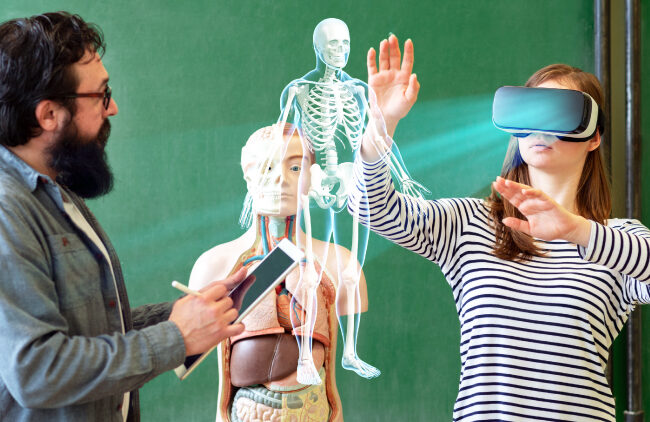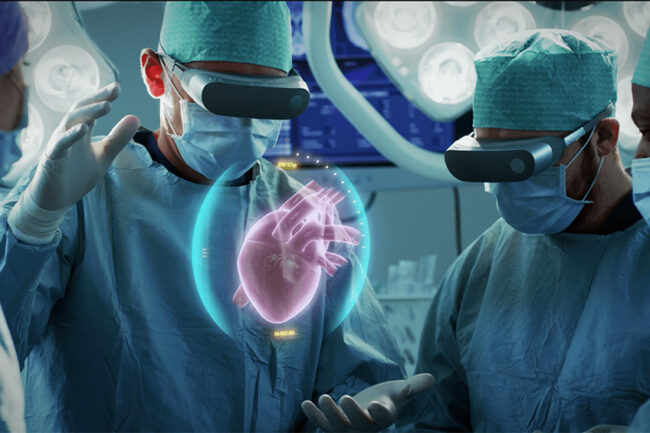Image Credit: Stella Jacob
Author: Valentine Gandhi
Virtual Reality (VR) technology has become increasingly popular in recent years, providing new opportunities for Monitoring, Evaluation, and Learning (MEL) processes. VR can create a digital environment that simulates real-life situations, providing an immersive experience that can enhance participant engagement and improve data quality. Despite the promises of VR for MEL, it also poses several perils, such as ethical concerns, technical challenges, and limited generalizability of findings. In this article, we will explore the promises and perils of using VR for MEL, providing examples of its application in different contexts.
Promises of VR for MEL
1. Enhanced Data Quality
VR technology can provide more accurate and reliable data than traditional methods. VR can simulate real-life scenarios, providing a controlled environment that allows researchers to observe participant behavior and collect data in a standardized way. For example, in the field of education, VR can simulate a virtual classroom, allowing researchers to observe and collect data on student behavior, interactions, and learning outcomes (Hofmann & Oberländer, 2017). VR can also enhance data quality by providing a more objective measurement of behavior, reducing the potential for observer bias (Schöning et al., 2017).
2. Cost-Effective
VR technology can be a cost-effective method for MEL processes, reducing the need for expensive and time-consuming fieldwork. Traditional MEL methods often require extensive travel, accommodation, and equipment expenses, which can be challenging to manage, especially for low-resource settings. VR can overcome these limitations by providing a virtual environment that mimics real-life situations. This can save time, reduce costs, and improve the accuracy and privacy concerns, particularly when collecting sensitive data. These ethical considerations must be carefully addressed, and participants’ safety and well-being should be prioritized.
3. Technical Challenges
VR technology is relatively new, and technical challenges can arise during implementation. VR requires specialized equipment, software, and technical expertise, which can be a barrier to implementation, particularly in low-resource settings. Technical challenges can also lead to data loss, inaccuracies, and errors, undermining the validity and reliability of the evaluation.
4. Cost
While VR is cost-effective in the long run, the initial costs of implementing VR can be high. VR equipment and software are expensive, and technical expertise may be required to set up and operate the system. This can be a significant barrier to implementation, particularly for small projects or organizations with limited resources.
Examples of VR in MEL
1. Education
 Image Credit: IXRLabs
Image Credit: IXRLabs
VR technology has been used in the education sector to enhance learning outcomes and improve teacher training. For example, a study by Hofmann and Oberländer (2017) used VR to create a virtual classroom to train future teachers in classroom management techniques. The study found that the VR-based training led to better engagement and learning outcomes than traditional training methods.
2. Health
 Image Credit: Visualise
Image Credit: Visualise
VR technology has been used in the health sector to provide immersive interventions and improve patient engagement. For example, a study by Chang et al. (2017) used VR to provide a virtual reality mindfulness meditation intervention to cancer patients. The study found that the VR intervention led to reduced stress and improved quality of life for the patients.
3. Environment
 Image Credit: Blue Health
Image Credit: Blue Health
VR technology has been used in the environmental sector to provide immersive experiences that enhance environmental awareness and education. For example, a study by Gkatzidou et al. (2021) used VR to create an immersive virtual tour of a landfill site, allowing participants to experience the impact of waste management on the environment. The study found that the VR experience led to increased environmental awareness and motivation to take action to reduce waste.
Conclusion
Virtual reality technology has immense potential for MEL processes, but it also poses several perils. It is essential to consider the promises and perils of VR carefully and assess its suitability for the project’s specific context. While VR can provide more accurate and reliable data, enhance participant engagement, and be a cost-effective method for MEL, it also poses ethical concerns, technical challenges, and limitations in generalizability. Therefore, it is crucial to carefully consider these factors when using VR for MEL and prioritize participants’ safety and well-being. VR has shown promising results in various contexts, such as education, health, and environment, and its application in MEL processes is likely to grow in the future.
References
Chang, Y., Lee, J. W., & Yoo, S. K. (2017). Virtual reality meditation for anxiety and depression reduction: A preliminary controlled study. International Journal of Human-Computer Interaction, 33(8), 1-6.
Gkatzidou, S., Mašić, A., & Rosli, H. (2021). Virtual Reality as a tool for environmental education: A study on a landfill site visit. Sustainability, 13(1), 1-17.
Hofmann, T., & Oberländer, A. M. (2017). Virtual classrooms for teacher education: Enhancing the quality of classroom management training. Technology, Pedagogy and Education, 26(1), 105-121.
Schöning, J., Scheibe, M., Arzt, L., & Hoffmann, W. (2017). Virtual reality in health care: A systematic review of literature. Topics in Health Information Management, 38(2), 1-13.

